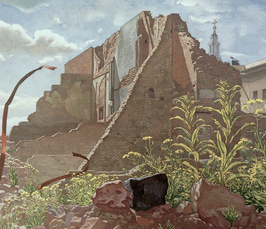The Pictorial Evidence of Ruins: From Rome to Homs
Conference
- Inizio: 14.11.2019 15:00
- Fine: 15.11.2019 13:00
- Luogo: Istituto Svizzero di Roma, Academia Belgica, Bibliotheca Hertziana – Max Planck Institute for Art History
- Contatto: freiberg@biblhertz.it

How did ruins turn into an independent figurative metaphor regarded as the epitome of transience? To what extent were the ancient Roman ruins transformed in the early modern period into iconic images of symbolic and aesthetic value and what is the relevance of this long process of transference—the elevation of the ruin to a sovereign image – for the way in which we view today's Syrian war ruins from a distance? In this context, one needs to differentiate between natural disintegration and planned ruination: what distinguishes the archaeological from the iconoclastic dimension of a ruin? The instrumentalization of the ruins of Palmyra which themselves became victim to a media-related iconoclasm in 2015 and the elevation of their void space after devastation into a social icon give reason to think critically about how the reception of ruins and the depiction of ruination combine anachronism with aesthetics and affect. Following these issues, we shall ask: What is the pictorial evidence of ruins and that of their images? In how far can images of ruins iconically convey or translate the nature of a catastrophe? To what extent does the aesthetic familiarity of the ruins of Rome as a visual paradigm of a ruined city raised by art since the 16th century contribute to our understanding of the new media-related impact of factual destruction today? Does aesthetics have an anaesthetic effect in this case?
With these questions, the conference seeks to contribute to the critical analysis of a pictorial concept of ruins from the early modern period to the present – spanned between destruction, restoration, and construction – and to ask how the issue of the media topicality of ruins can be dealt with today.
***
Program
Thursday, November 14, 2019
Afternoon session (Istituto Svizzero):
Chair: Ralph Dekoninck (Catholic University of Louvain-la-Neuve)
15.15–15.45 – Mateusz
Kapustka (University of Zurich/FU Berlin):
Ruins, Ruination, and
Anachronism. An Introduction
15.45–16.30 – Henri de
Riedmatten (University of Geneva):
Recoding
Fragmented Figures: Dynamics of Restoration in Early Sixteenth-Century Rome
16.30–17.00 – Coffee break
Chair: Tatjana Bartsch (Bibliotheca Hertziana)
17.00–17.45 – Jumana Al
Asaad (University of Heidelberg):
The Iconization and Medialisation of the Syrian
Cultural Heritage in the Ongoing Armed Conflict
Friday, November 15, 2019
Morning session (Academia Belgica):
9.00–9.15 – Sabine van Sprang (Academia Belgica): Welcome
Chair: Barbara Baert (KU Leuven)
9.15–10.00 – Maarten Delbeke (ETH Zurich):
Getting Rid of the
Ruins. Remnants as Sources of Knowledge and Confusion in the Late 17th Century
10.00–10.45 – Dirk de
Meyer (Ghent University):
Palmyra to Europe and back. Architectural Ruins and
their Mediatization
10.45–11.15 – Coffee break
Chair: Tristan Weddigen (Bibliotheca
Hertziana)
11.15–12.00 – Stanislaus
von Moos (University of Zurich/Getty Research Institute):
Constructivist Ruins?
On Frank Lloyd Wright and Peter Blume
12.00–13.00 – Lunch break
13.00–13.45 – Robert
Harbison (London):
Ruins and Fragments in
Modern Sculpture
13.45–14.15 – Concluding remarks and discussion